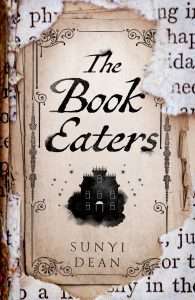Adrian Collins's Blog, page 87
August 7, 2023
REVIEW: The Witcher S3
Henry Cavill’s time as Geralt of Rivia comes to a close in a 2-part third season of The Witcher. Loosely adapting Andrzej Sapkowski’s popular fantasy books, The Witcher S3 finds a cast comfortable in their roles as Geralt, Yenifer, and Ciri band together in an attempt to stop what seems to be pretty much everyone in the Continent from capturing the magical princess. This is Ciri’s season, make no mistake, as she uses her lessons from Kaer Morhen to take care of herself in the monster-filled world.
There’s a slow start to the season overall. The fight scenes are still choreographed better than most shows and Cavill has an understanding of the character that his successor Liam Hemsworth will have to work bloody hard to recreate. However, the CGI is a bit off in places (something that can be seen in many TV series and films lately) and this definitely impacts the viewing of what should be some of the best fights in the series to date. Still, there are lots of positives to The Witcher S3. Fans of the wildly successful The Witcher 3: The Wild Hunt game will notice characters and costumes becoming more like what they expected and the scenes with Geralt, Ciri, Yennefer and Jaskier are signs of these characters have grown throughout the series to become a family, each doing their best to protect one another at the cost of all else. Yennefer in particular has had a satisfying arc and the way in which she calls Ciri her daughter is impactful when her whole journey is taken into consideration.
The Witcher S3 has one of my favourite episodes of the series so far. Episode 5: The Art of Illusion takes place at the Conclave of Mages with Geralt on Yennefer’s arm dressed out in his finest clothing and Cavill giving his best surly performance of the show yet. Whilst Ciri is being cared for by Jaskier, Geralt and Yen work the room in an attempt to identify the person responsible for targeting Ciri. The non-linear structure of the episode mixed with clever plays on time and direction (multiple angles showing the same conversations) bring a bit of clever innovation to a series that has sometimes fallen short when attempting something different. The episode shows the potential of The Witcher with the acting, writing, and direction all magnificently on point to deliver suspense, intrigue, and just a load of fun to a series that sometimes felt a bit lost. The episode ends with some solid action to satisfy the bloodthirsty viewers but at the end of the series, I was left with a bittersweet feeling of lost potential within a world that could be so much more. Whilst better than most of Amazon’s The Rings of Power, The Witcher S3 never quite hits the heights of Game of Thrones or House of the Dragon and we will have to see if season 4 can do better with Liam Hemsworth in the lead role.
A series with incredible highlights but a lack of consistency means that Cavill’s final season is bittersweet. There’s more magic, fighting, and The Witcher S3 leans closer to the aspects of the game that made Netflix fork out the big bucks for such a property. But whilst this show is entertaining for many fantasy fans, it never quite reaches its full potential aside from a few moments of brilliance. The Witcher S3 is a series starting to find its feet and it will be interesting to see what happens next – I’m just not sure all the fans will come along for the ride.
The post REVIEW: The Witcher S3 appeared first on Grimdark Magazine.
August 6, 2023
An Interview With Charlaine Harris
Charlaine Harris is a New York Times bestseller, and author of the HBO adopted series “Sookie Stackhouse,” NBC adopted “Midnight, Texas,” “Harper Connelly,” and many more. Harris has joined us to discuss her latest novel, All the Dead Shall Weep, the fifth installment of the dark magic and Western series. “Gunny Rose.”
 [GdM] Each of the worlds you build are dynamic, intricate, and very different. Do you start with one idea or a broad sense of the place and fill in the details as you write?
[GdM] Each of the worlds you build are dynamic, intricate, and very different. Do you start with one idea or a broad sense of the place and fill in the details as you write?
I start with the protagonist and the story I’m trying to tell through her. I build the world around that. It starts very small, and as I work in my head that world begins to expand and become more precise.
[GdM] Can you tell us about the “Gunnie Rose” series?
It’s another venture in new territory for me. I guess the series is best defined as an Alternate History Western with a gunslinging heroine. She’s not bloodthirsty, but she’s upright and determined to do her job, which is protection. Lizbeth Rose is very young, and very independent. At first, I planned on no magic in her world, but I changed my mind as it evolved.
[GdM] Have you always been interested in westerns? Is there anything specific that intrigues
you?
I haven’t always been interested in westerns as a genre, but I did spend part of every summer in Texas as a child. The difference in the culture between central Texas and the Mississippi Delta (where I grew up) was very marked, and made a deep impression on me.
[GdM] Along with the western-style story, the “Gunnie Rose” series has a lot of parts that borrow from Russian history and culture. What was the impetus for these two cultures coming together?
I’ve always been intensely interested in the last of the Romanovs, and I realized it was possible to work the family into the history of fractured America. Russia had a great presence in the northern part of the Pacific coast many years before that, and it all made sense to me.
[GdM] Are there stylistic overlaps between Russian storytelling and traditional Western
storytelling?
I have no idea. But stories, particularly folkloric stories, always have a commonality.
[GdM] There is a genuine sisterly authenticity in the relationship between Felicia and Lizbeth.
Having an older sister myself, I felt like I understood Felicia and Lizbeth’s relationship perfectly.
In book four, The Serpent in Heaven, the readers get an opportunity to learn more about their
relationship. Was this modeled on a real-life relationship?
I have never had a biological sister, though I have several women friends whom I consider that close to me. I did have an older brother, and three children. I played around with that inside my head.
[GdM] Can you tell us about your newest release, All the Dead Shall Weep?
I’d love to. It was a hard book to write for several reasons, and I rewrote extensively. I feel really good about the result. “All the Dead Shall Weep” once again features both sisters, when Felicia and Eli’s brother Peter come to visit Lizbeth and her husband Eli in Segundo Mexia. It’s anything but a smooth visit, and Eli and Peter don’t show the best sides of themselves in the aftermath of a militia attack on the town. Felicia also learns that her power is attracting close attention in the magical world. Lots of action!
[GdM] Who is Lizbeth Rose, and how did she come about? How has Lizbeth developed from the first book, An Easy Death, until now with the release of All the Dead Shall Weep?
I was invited to write a short story for a Shawn Speakman anthology to benefit charity, and I was really anxious to write something new and different; to cleanse my writer palate. I decided I wanted to write about a woman who shoots a lot of people, and Lizbeth gradually came into being. Then the world that she had to operate in to achieve those goals grew around that. After I’d written the story, I found I wanted to write more about her.
[GdM] The magic system of the “Gunnie Rose” world is fascinating; how did you develop it?
Any mention of the Russian royal family has to include Grigori Rasputin, right? So, he was the door to creating the magical world of the series. And if he had magic, then the rest of the world had to have its magic. It seemed to me that no matter what form or name the magic had, or how its practitioners used it, it would be drawn from the same well.
[GdM] All the Dead Shall Weep has alternating points of view from Felicia and Lizbeth, but each has a distinctive voice. As a writer, how do you create an authentic voice for each character so that they stand out between alternating chapters?
It’s sort of like method acting, I suppose. It’s method writing! I think myself into those characters and I write with those voices. It’s interesting technically, and I’ve really enjoyed it.
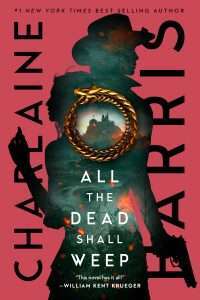 [GdM] While the story focuses mainly on Lizbeth and Felicia, their partners are vital parts of
their lives. As supporting characters and partners, how do Eli and Peter allow Felicia and Lizbeth to flourish?
[GdM] While the story focuses mainly on Lizbeth and Felicia, their partners are vital parts of
their lives. As supporting characters and partners, how do Eli and Peter allow Felicia and Lizbeth to flourish?
Or not! Eli is not a universally admired character, and Peter has some character flaws, too, but he’s growing up. Eli is restive in this book, which I think would be natural. He loves Lizbeth and he can’t go back to his former life, but he feels the lack of his former status and activities. It’s a period of adjustment for the married couple, and they’re working on it. Peter is growing up from the impulsive boy he was to a mature man, but he’s just as unhappy with the job he got assigned after graduating from the Rasputin school. He loves Felicia, but she’s a real star . . . and he’s not.
[GdM] You have written several fantastic series, “Sookie Stackhouse,” “Aurora Teagarden,” and more. Are there any that are particularly close to your heart? Which one was the most fun to write?
That’s a really hard question to answer. Aurora was really close to my heart, my first series, and closely attached to the life I had then. They were all fun to write, or I wouldn’t have written them. My whole career is about keeping myself entertained, and in the process, entertaining others. I have enjoyed writing characters who were completely different from me, like Harper Connelly, and characters who only had a limited connection with me, like Lily Bard. Sookie was a funhouse from start to finish, and now I’m living with Gunnie Rose. I love my life.
[GdM] You have had series go to television. What is it like seeing your books in a different medium?
It’s pretty shocking at first. “True Blood” was a huge learning curve for me. I’d never met actors, never been on a set, had no idea how the hierarchy worked in that business, and was quite shocked at the attention the show drew to me. But there were fun benefits, too. I did better with the “Midnight Texas” experience, and even better with the Hallmark movies about Aurora Teagarden. I have been to all the sets, met some of the actors, and tried to learn in the process. I have found it’s best to separate the two experiences, my books and the film adaptation. I’m responsible for my books. I’m not responsible for the adaptation. I just need to sit back and enjoy any benefit the adaption brings to the books, like increased sales.
[GdM] What is next for you after the release of All the Dead Shall Weep?
I’m working on the next Gunnie Rose. After that, we’ll see.
Thank you for taking the time to answer these questions!
READ ALL THE DEAD SHALL WEEP
The post An Interview With Charlaine Harris appeared first on Grimdark Magazine.
August 5, 2023
REVIEW: Those Left Behind by N.C. Scrimgeour
N.C. Scrimgeour’s debut series, The Waystations Trilogy, is billed as ‘perfect for fans of Mass Effect, The Expanse and Star Wars’ and the first instalment, Those Left Behind is an excellent introduction to this space opera that will please readers who enjoy darker themes in their sci-fi. Coming second in the latest Self Published Sci-Fi Competition, Those Left Behind proves itself to be a strong contender in the realm of modern sci-fi.
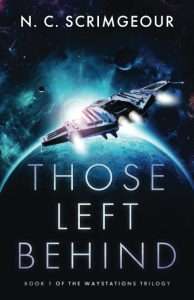 Those Left Behind starts on New Pallas; a planet of humans that is overwhelmed and on the brink of total collapse. With 50 billion residents, the only hope for survival is a scouting mission out into the black of deep space in search of habitable worlds. Tensions on board captain Alvera Renata’s ship are already smouldering before they are underway – the humans of New Pallas have divided themselves between those from the surface, and those who live on the floating Exodus station that orbits the planet. Exodans have embraced cybernetic adaptations and view surface-dwellers as obsolete. Some believe they should abandon those living on the planet entirely and only evacuate Exodans when a new world is found. Renata struggles from the start to ensure her crew understand that they will be saving everyone or no one.
Those Left Behind starts on New Pallas; a planet of humans that is overwhelmed and on the brink of total collapse. With 50 billion residents, the only hope for survival is a scouting mission out into the black of deep space in search of habitable worlds. Tensions on board captain Alvera Renata’s ship are already smouldering before they are underway – the humans of New Pallas have divided themselves between those from the surface, and those who live on the floating Exodus station that orbits the planet. Exodans have embraced cybernetic adaptations and view surface-dwellers as obsolete. Some believe they should abandon those living on the planet entirely and only evacuate Exodans when a new world is found. Renata struggles from the start to ensure her crew understand that they will be saving everyone or no one.
Punching a hole through space, Renata and crew arrive in a new galaxy to discover they are not alone in the universe. They’re not even the only humans out there. As they stumble into a volatile political landscape that is not happy to see them, Exodan mutineers take over causing Renata and allies to scatter across this new galaxy in hopes of staying alive. Those Left Behind takes them to dangerous planets to deal with criminal bosses, bounty hunters and worlds whose atmosphere will stop them dead. All the while, war teeters on the tip of the galaxy’s tongue and New Pallas is all but abandoned to its terrible fate in the name of the greater good.
What our plucky humans didn’t know is that they have inadvertently started a huge doomsday clock that heralds the arrival of something intent on destroying all life in the galaxy. As different factions of occupied space posture against each other, the countdown forces some turbulent decisions that cost lives. Those Left Behind creates a convincingly ominous threat ‘behind the curtains’ to keep at the back of your mind. Even as characters are witnessing and committing their own atrocities in the name of protecting the galaxy, their people and their friends, there is something much worse lurking just off stage.
Across its pages, Those Left Behind approaches some heavy themes, such as eugenics, genocide and warmongering. Violence isn’t strictly commonplace but can be brutal. Alvera Renata is a case-study in grey morals and the way Scrimgeour has told her story makes you want to root for her. There are despicable villains to hate and desperate shimmers of hope to cling to throughout Those Left Behind. The story leaves you with enough questions to propel you forward in the series but not so many as to be frustrating. The prose is quick and clever with subtle world-building and deep characters. The second and third books in the series, Those Once Forgotten and Those Who Resist, are already published and available for those who don’t like to wait.
Read Those Left Behind by N.C. ScrimgeourThe post REVIEW: Those Left Behind by N.C. Scrimgeour appeared first on Grimdark Magazine.
August 4, 2023
REVIEW: Cassiel’s Servant by Jacqueline Carey
The central precept of d’Angeline society is ‘Love As Thou Wilt’. That is, for everyone except for Cassiline monks. The adepts of Cassiel are celibate warrior-monks, trained in a highly ritualized manner of combat from boyhood, isolated in a highly sexualized society. Jacqueline Carey’s latest novel, Cassiel’s Servant returns readers to the familiar world of Terre d’Ange from her Kushiel novels – which have become a cornerstone of the genre over the course of the two decades since the initial publication of Kushiel’s Dart. For those who are familiar with the novels, Cassiel’s Servant retells the events of Kushiel’s Dart from the perspective of Joscelin Verreuil, whereas Kushiel’s Dart and the subsequent books are told from Phèdre’s point of view. This means that this is a great point to enter the world of Terre d’Ange, just as much as it is a wonderful homecoming for those of us who have visited before.
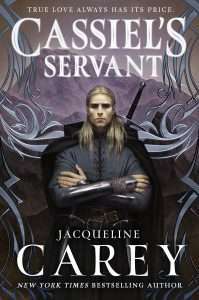 Phèdre was born with a scarlet mote in her eye – Kushiel’s mark. This means she will always feel pain and pleasure as intertwined sensations. And Joscelin Verreuil is assigned to guard her. A newly graduated Cassiline monk, sworn to celibacy, is honour-bound to protect a courtesan and spy. What could go wrong, you ask? Well… Phèdre stumbles over a political conspiracy and they find themselves sold as slaves, and a long and arduous journey to bring word back and save Terre d’Ange begins.
Phèdre was born with a scarlet mote in her eye – Kushiel’s mark. This means she will always feel pain and pleasure as intertwined sensations. And Joscelin Verreuil is assigned to guard her. A newly graduated Cassiline monk, sworn to celibacy, is honour-bound to protect a courtesan and spy. What could go wrong, you ask? Well… Phèdre stumbles over a political conspiracy and they find themselves sold as slaves, and a long and arduous journey to bring word back and save Terre d’Ange begins.
Reading Cassiel’s Servant took me back to the first time I read Kushiel’s Dart, as a starry-eyed and innocent first-year undergraduate. The books were already backlist then, out for a few years, but I fell in love immediately. Jacqueline Carey’s world is vibrant and far-reaching, stretching countries and continents, religions and cultures, all of which are presented with layers of bright detail. Terre d’Ange itself is most closely based on Renaissance France and Italy, and in Cassiel’s Servant alone, we spend time in a Slavic- and Celtic-inspired culture respectively. Reading this new story in the same world made me realise how well the books still hold up – and I’m now desperately due a re-read of the entire series.
First published shortly after the turn of the millennium, the motto of ‘Love As Thou Wilt’ is taken as crucial to both story and society. It is essentially a queernorm world, kink-friendly, with codified social places for sex workers and a religious system that is explicitly pro-choice for those able to bear children. Cassiel’s Servant, looking at this world from the perspective of one sworn to celibacy makes it even more starkly obvious how remarkable Carey’s worldbuilding is in that respect.
I absolutely devoured Cassiel’s Servant – its lush prose, brilliant characters and the nostalgic pull of the world itself all contributed to how much I loved diving back into Terre d’Ange. It was great to see the story through Joscelin’s point of view after spending a lot of time in Phèdre’s, giving this a similar reading experience as I tend to have with retellings. I didn’t know exactly how the story would be told, but I was familiar with the broad beats of how the plot would move from event to event. Joscelin is a very different character to Phèdre, calmer and more cautious in many ways, but also physically stronger and pious in a very different way. He spends much of the book trying to come to terms with betrayal and his relationship to the Cassiline Order, as well as his faith, while being pulled in a very different and unexpected direction. Phèdre and Melisande, familiar to readers of the original books, are back in all their grimdark glory, Phèdre fighting for what she believes in and Melisande, well, she is my favourite villainess of all time. And that’s just three of the many, many brilliant characters we meet and spend time with in Cassiel’s Servant.
Do yourself a favour and join me in Terre d’Ange – pick your poison, the newly written Cassiel’s Servant from Joscelin’s perspective, or the classic Kushiel’s Dart from Phèdre’s.
Read Cassiel’s Servant by Jacqueline CareyThe post REVIEW: Cassiel’s Servant by Jacqueline Carey appeared first on Grimdark Magazine.
August 3, 2023
An Interview with Sunyi Dean
Sunyi Dean’s debut novel, The Book Eaters was an instant #2 Sunday Times Bestseller in the UK and is a firm favourite among the Grimdark Magazine team (read our review HERE). She is currently nominated for the Sydney J. Bounds Award for Best Newcomer at the British Fantasy Awards and in her spare time, runs the podcast The Publishing Rodeo with fellow Tor author Scott Drakeford. They aim to demystify the publishing industry for those outside of it – so a great place to listen in to learn about the ins and outs of publishing! She is a biracial autistic author who has now settled in Yorkshire after growing up in the US and Hong Kong, so brings a wealth of different experiences with her. We were able to sit her down for a chat about The Book Eaters, writing, and publishing ahead of the paperback’s publication.
[GdM] Let’s start off with an easy one, what would The Book Eaters taste like to Devon?
[SD] Gunpowder and peat (a soil found in the moors that gives whisky a smokey flavour) for sure!
[editor’s note: that sounds pretty damn delicious!]
[GdM] Following on from that, if you were able to absorb books like the book eaters, what three books would you choose to internalise and gain the knowledge from?
[SD] The History of Western Philosophy by Bertrand Russell, which is a wonderful tome that changed my life. (I know we can have three, but that one is so big I think it probably counts as many books in one!)
[GdM] How would you describe The Book Eaters as you’re back into a second promotional cycle, and how has that perhaps evolved since it first came out?
[SD] That probably depends how many words I have, and who my audience is! I think I tended to focus on the book eating aspect initially, but I would probably centre on Devon’s core dilemma these days (needing to feed good people to her evil son.)
[GdM] What was your process for The Book Eaters like? Did you create the characters and the world and story followed or did you rather have the world and themes and find characters to populate it?
[SD] I start with an emotion I want to describe, or a way that I hope readers will feel at the end of a novel, and then I craft the story around that. Anything and everything can change–plot, characters, world, genre, all of it, in service and in sacrifice to nailing a given emotional state.
[GdM] I really loved all the chapter epigraphs throughout the book – how did those come to the story?
[SD] Thanks so kindly! The epigraphs served about 4 functions  First, I just love epigraphs as a ‘cheaty’ way of doing worldbuilding. Devon’s point of view is so limited, and there are so many things she doesn’t think to wonder about, or has no way of knowing, and this gets around her limitations. Second, I wanted to use Mani’s snippets to showcase some of his character, and help the reader to not forget he existed during the long swathe where he isn’t present. Third, I wanted to reference the stories or ideas that influenced Book Eaters, and help give readers a little context. And fourth, I was trying to use them as a signpost for the timeline switching: fairytale quotes signal past-tense chapters, while ‘research quotes’ from Mani’s book signaled present-day chapters.
First, I just love epigraphs as a ‘cheaty’ way of doing worldbuilding. Devon’s point of view is so limited, and there are so many things she doesn’t think to wonder about, or has no way of knowing, and this gets around her limitations. Second, I wanted to use Mani’s snippets to showcase some of his character, and help the reader to not forget he existed during the long swathe where he isn’t present. Third, I wanted to reference the stories or ideas that influenced Book Eaters, and help give readers a little context. And fourth, I was trying to use them as a signpost for the timeline switching: fairytale quotes signal past-tense chapters, while ‘research quotes’ from Mani’s book signaled present-day chapters.
[GdM] What have you learned as a writer and professional author between hardback and paperback publication you wish you knew beforehand?
[SD] So much stuff! For example, before publishing days, I didn’t even parse quite why some books are hardcover or soft cover, what that meant, why there was a gap in publication, etc. It was just one of those Mysterious Publishing Things. If I could go back, I think I’d have enjoyed knowing some of the thousands of different factors that can impact the sales performance of those formats, and just a general sense of what to expect.
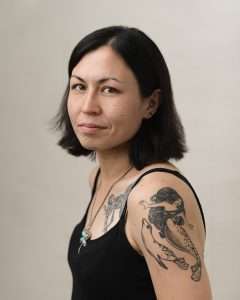
Credit: Mark Hillyer at True North Studios
[GdM] What has been the most surprising aspect of being a debut author?
[SD] How much success can hinge on a slew of tiny decisions by individual people in random circumstances. The right editor at the right house, pitched by the right agent. The right sales person liking your book. The right bookseller getting excited about it. The right store buyer taking a punt, the right reviewer getting sent your copy. None of those things will individually make or break a book, but all of those things aligning can launch a novel, and enough of them going right in a row will have a cascading effect in your favour. Likewise, enough of them going wrong in a row can tank a title. It’s daunting to realise how much hinges on so little.
[GdM] How has working on your podcast, The Publishing Rodeo, impacted your own experience of being in the publishing industry?
[SD] … The podcast has been the surprise of the year for me! I know I’ve said this in other places, but Scott and I really did think it would be such a niche topic, of interest to perhaps a few dozen nerdy authors. It felt a bit like shouting “marco” into an empty forest and having all the trees yell “POLO” back at you en masse. That makes it sound like a horror flick, sorry! What I’m trying to convey is how amazing it was to discover other authors and industry folks who were excited to have conversations about publishing in the open, and the great sense of camaraderie that came about from those chats.
[GdM] Why make writing, and reading, such an entirely human ability and pursuit in The Book Eaters?
[SD] I suppose because I think of it as such a specifically human activity. It’s debatable to me whether we really are more intelligent than other animals, since we coincidentally define intelligence as having human-centric traits. But we are definitely, so far as we know, the only species on this earth who read and write for fun as well as function. I think any alien studying us would be drawn to investigate why that is.
[GdM] As a neurodivergent reader, the way the book eaters learn through absorption of theoretical knowledge rather than empirical understanding struck me as a great allegory for neurodivergence in a neurotypical society. Was this intentional?
[SD] Definitely wasn’t! Though that’s a cool idea 
[GdM] Besides The Book Eaters, you’ve also published some stellar short fiction. I’ve particularly enjoyed “How to Cook and Eat the Rich”. How does your creative approach differ for long and short form projects?
[SD] Thanks so kindly! Novels are projects that I sit and work at, like a job. Short fiction I can’t do that; I can’t force it. I write small stories when I have ideas for them, or unusual structures that I want to have fun exploring. When I was figuring out dual timelines, for example, “The Thief of Memory” became a playground for experimenting with that narrative structure. All that said, I think I am more proud of my short fiction than my novels. You have more freedom to be weird and unusual in shorts, with less commercial ‘risk’ and less professional pressure since they don’t pay much anyway.
[Editor’s note: both the short stories mentioned are available to read on tor.com – just click on the titles!]
[GdM] What are you working on next?
[SD] I’m currently working on a historical spec fic novel set in Hong Kong, featuring water spirits, ghost cats, and angry dead women. The story moves between the outlying islands during World War 2, and Kowloon Walled City in the 1960s. It is thematically and structurally very different from Book Eaters, a little slower and more character centric, but hopefully with a few fun twists thrown in.
[GdM] What books or other media have been filling your creative well recently?
[SD] I’m currently reading The Last Hour Between Worlds by Melissa Caruso in ARC format, and recently finished The Book of Doors by Gareth Brown. Both recommended! Television-wise, I always recommend Severance, I’m still working through season 4 of For All Mankind, and also really enjoyed Silo, having bounced off the books (but I might try them again!)
Read The Book Eaters by Sunyi DeanThe post An Interview with Sunyi Dean appeared first on Grimdark Magazine.
August 2, 2023
Lenses on Complicity: Character Arcs in Pact & Pattern – J.T. Greathouse
As the Pact & Pattern series draws to a close, I think readers might be interested in getting a behind-the-scenes look at some of my thought process in writing these books. One element of the series that I’m particularly proud of is its treatment of character, particularly its exploration of theme through dynamic characters whose perspectives shift and change across the narrative. The Pattern of the World, the final book in the trilogy, is particularly focused on this element – on characters coming to understand their world, and themselves, in new ways. Or, sometimes, failing to do so.
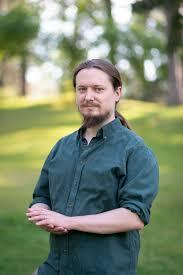 While I won’t talk about The Pattern of the World itself in this article (it is about a month out from release at time of writing, after all) I will outline the methodology I have used in my approach to character in the series, with some examples from the first and second books. For readers who’ve been with me from the beginning, hopefully this will stimulate some thought about the character arcs in The Hand of the Sun King and The Garden of Empire, and prime you to keep your eye out for these elements in The Pattern of the World. If you’ve yet to read the first two Pact & Pattern books, you can still read on, though might have some plot points and character arcs spoiled for you.
While I won’t talk about The Pattern of the World itself in this article (it is about a month out from release at time of writing, after all) I will outline the methodology I have used in my approach to character in the series, with some examples from the first and second books. For readers who’ve been with me from the beginning, hopefully this will stimulate some thought about the character arcs in The Hand of the Sun King and The Garden of Empire, and prime you to keep your eye out for these elements in The Pattern of the World. If you’ve yet to read the first two Pact & Pattern books, you can still read on, though might have some plot points and character arcs spoiled for you.
I’m generally a believer in the maxim, coined by William Faulkner, that the only thing worth writing about is the human heart in conflict with itself. There are certainly other things in my books than angst and internal agony, but the heart of a story lies in its characters, and the heart of the best characters, in my opinion, is internal conflict.
It is tempting, at this point, to launch into a lengthy diatribe on the notion that to be human is to be in some way dissatisfied with yourself, but I think that such a feeling may in fact be unique to novelists (or, perhaps, specific only to me). However, I do think most people will at some point in their life experience a profound internal conflict, a struggle of some sort between the self you are and the self you want to be. This struggle may occur as part of adolescence, or later in life when faced with difficult decisions, or crumbling relationships, or a failure to measure up to your own expectations, or a crisis of faith (in religion, or in government, or in the mission of their career). Perhaps an experience teaches you a profound moral lesson, one which, in order to be applied demands a change in career – your newfound sense of morality must now struggle against the comfort of stasis, the cost of leaving one path, and the difficulty of finding another. Two sides of the self – the new, morally enlightened self and the old, comfortable self – wrestle one another until one overcomes or some compromise is reached.
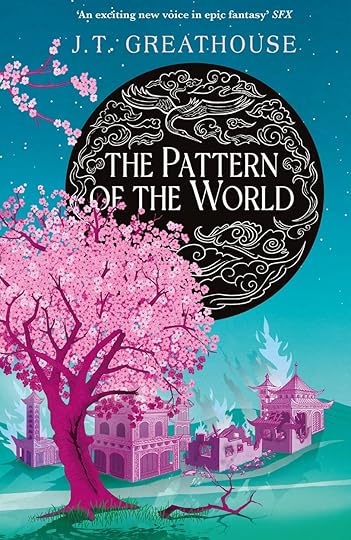 This may not happen to everyone, though I would argue it will happen to most thoughtful people at some point in their life (and we as readers would like to think of ourselves as thoughtful people). On reflection, some element of the self must change – but that realization is not enough. In my opinion, the best fiction reflects this struggle, “old world passing away while a new one struggles to be born” within a person’s heart.
This may not happen to everyone, though I would argue it will happen to most thoughtful people at some point in their life (and we as readers would like to think of ourselves as thoughtful people). On reflection, some element of the self must change – but that realization is not enough. In my opinion, the best fiction reflects this struggle, “old world passing away while a new one struggles to be born” within a person’s heart.
War & Peace, one of my favorite novels and one of the best examples of dynamic characterization in the novel form, is focused almost exclusively on these sorts of character arcs. Pierre Bezukhov, the nearest thing the book has to a protagonist, exists in an almost constant state of self dissatisfaction. He begins the novel a drunkard, a gambler, and a rabble-rouser of the highest order. His introduction takes the form of two characters discussing his most recent stunt – strapping a police officer to a bear and hurling them both into the Moyka river. But he is also deeply thoughtful and sensitive, and knows that his behavior is absurd and foolish. After he comes into a sudden inheritance, Pierre spends nearly the rest of the novel trying to figure out what to do with it, how to become the sort of person who can effectively deploy his newfound wealth for the betterment of society – often stumbling along the way over his many vices and weaknesses. Almost every character in the novel faces a similar dilemma. There is a version of themself they want to be, but which they fail to measure up to, and their story explores their efforts to reconcile that incongruity.
Far be it from me to compare myself to Tolstoy, but in almost all of my writing I try to do the same thing, often as a way to explore and unpack my own internal struggles. In the case of the Pact & Pattern books, each point of view character represents a different lens on the same internal struggle – a struggle with complicity in wrongdoing. Each character, at some point in the story, for different reasons, performs acts – whether of direct violence or mere complicity in larger, harmful systems – that they come to perceive as wrong.
In The Hand of the Sun King, Alder’s arc in these terms is quite clear. In the first act of the novel, he decides to work for the very empire that has oppressed his homeland in exchange for a chance to fulfill his personal ambition of mastering magic. The story subsequently engages him to confront the harms of the empire, and ultimately his own complicity in those harms, as part of the process of returning to his identity as Foolish Cur. The later books push him to examine how he has been shaped by the time he spent in the empire’s service, and how that shaping reverberates and echoes through his attempts to solve problems – many of which he caused himself. The central question for Foolish Cur in The Pattern of the World moves beyond his complicity in the empire, and demands something even larger of him – an examination of his obsession with magic itself.
The other point of view characters – Pinion, Koro Ha, and Ral – experience similar confrontations. Each of their arcs is meant to in some way mirror, or invert, or highlight specific elements of Foolish Cur’s, attempting to present a view of the idea of complicity from many angles. I doubt that I have succeeded in doing so in a way that is as compelling to my readers as Pierre Bezukhov’s struggles are compelling to me (again, I am not, and will never be Tolstoy), but I hope, at the very least, that these characters and their struggles resonate with some of my readers, and help them to consider and reflect upon their own lives and their own struggles – the conflicts that have, at times, turned their own hearts against themselves.
The post Lenses on Complicity: Character Arcs in Pact & Pattern – J.T. Greathouse appeared first on Grimdark Magazine.
August 1, 2023
REVIEW: The Heart of What Was Lost by Tad Williams
Tad Williams said that when he finished Memory, Sorrow and Thorn he thought he was done with the world. The hints of prophecy for things to come were just to imply that, while this particular story had ended, Osten Ard was a living world and more things would happen, off-page. Two decades later, he opted to amend that, with his The Last King of Osten Ard quadrilogy and a few stand-alone novels.
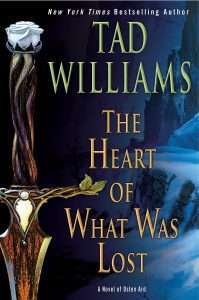 The Heart of What Was Lost is an interquel novel, one that is intended to bridge the gap between Memory, Sorrow and Thorn and The Last King of Osten Ard. It takes place in the aftermath of the attack on the Hayholt, or Asu’a in the language of the Sithi and the Norns. The Norns are forced to retreat after their defeat, and are heading back towards their home in the mountain of Stormspike, but are being harried by Duke Isgrimnir every step of the way.
The Heart of What Was Lost is an interquel novel, one that is intended to bridge the gap between Memory, Sorrow and Thorn and The Last King of Osten Ard. It takes place in the aftermath of the attack on the Hayholt, or Asu’a in the language of the Sithi and the Norns. The Norns are forced to retreat after their defeat, and are heading back towards their home in the mountain of Stormspike, but are being harried by Duke Isgrimnir every step of the way.
In Memory, Sorrow, and Thorn, the Norns are viewed as threats, and while we get occasional references to their past and the separation of the Sithi and the Norns, we never really understand them. Williams begins to change that here, with one of the points of view being a Norn engineer, of the Order of Builders.
The Norn customs and castes are laid out with far more detail, grounding them into this world in a way they never had been before. Their numbers have dwindled and continue to do so, and each one who falls is one who cannot be replaced. They have greater skill, cunning, and magic, but the humans just keep coming. We see how their society is structured, around a combination of lineages and various Orders, including the Builders, or engineers, Sacrifices, or soldiers, Song, or magic, and more. Viyeki is being groomed to take over the Order of Builders from his mentor Yaarike.
We also see the machinations of other Norn leaders while their Queen Utuk’ku, who spent much of her energy, is unconscious and recuperating in a deep magical slumber. Even though the Norns are dwindling in numbers and the humans are pursuing them with every intent of destroying them, many still act as if everything is as it always has been, playing political games and worrying about bloodlines.
We also see Duke Isgrimnur, a major character in the original trilogy, as the main point of view of the human’s side of things. He’s dealing not just with the threat of the Norns, but the responsibility of leading a large army against them. The army is haphazard, and plenty of the groups are less concerned with maintaining order than they are with getting revenge. He’s trying to force people used to small, direct attacks into the more orderly and structured plans of a large army, with mixed results. The humans might have the numbers, but they lose more than necessary because of groups seeking glory or revenge for themselves.
The other point of view is Porto, a Perdruinnese soldier a long way from home, who befriends another soldier from his hometown. Their plotline is to show the attack from the points of view of regular soldiers, and it also maintains more heart than either of the others.
As the attack goes on the Norns do eventually retreat into Stormspike, at which point the story changes to a siege. Williams’ prose is at its usual level of excellence, making Osten Ard feel like a lived-in world. The plot fleshes out the Norn’s culture and what happens to them in the aftermath of the battle of the Hayholt. As an interquel novel, it is likely not a necessary read before The Last King of Osten Ard, but it’s absolutely worth it to spend more time in this world.
Read The Heart of What Was Lost by Tad WilliamsThe post REVIEW: The Heart of What Was Lost by Tad Williams appeared first on Grimdark Magazine.
July 31, 2023
What we know about Joe Abercrombie’s Best Served Cold so far
Joe Abercrombie has etched his name deeply into the annals of fantasy fans – particularly those of a more grimdark persuasion. As SFF becomes more and more popular, with TV and film studios rushing to find the next Game of Thrones, Abercrombie and his books are frequently put forward by fans as excellent candidates for adaptation.
Their wishes were answered earlier this year, after it was announced that a movie is in the works based on Best Served Cold, an Abercrombie novel set in his hugely popular First Law World. Detail is scant on the adaptation at this stage but what we do know is filling fans with excitement.
And don’t just take my word for it. Sarah Ferguson, the only member of the cast currently announced, says she is ‘very, very excited’ about what’s to come – something that bodes well for Abercrombie’s legions of fans.
She told Collider last month: “We were just talking about casting and who we want around. I’m very, very excited.
“We’ll see now with strikes and everything that’s happening, but everything will happen in its own time.”
So what do we know about the most anticipated fantasy adaptation of the year?
What is Best Served Cold?Set in the First Law World but outside the beloved main trilogy, Best Served Cold follows Monza Murcatto, an infamous mercenary.
It tells the story of Monza as she tries to get revenge on seven people who killed her brother before leaving her for dead.
We see her get a crew together, with some familiar faces from Abercrombie’s other books. You won’t need to have read anything else to enjoy Best Served Cold, however.
Who’s the director/writer?Best Served Cold will be directed by Tim Miller for Skydance.
Miller has a rich body of work and made his feature-film debut with Deadpool, something that certainly shares similarities in tone with Abercrombie’s work. If he is given the greenlight to go all out, then grimdark fans could be in for a treat.
More recently, he is the man behind the popular and award-winning Love, Death & Robots series. Though animated, the series has been praised for its combination of comedy, horror, sci-fi and fantasy.
Excited yet, grimdark fans? Well, the writer of the screenplay is one Joe Abercrombie himself.
Announcing the news on Twitter, he lavished Miller with praise and explained: “We’ve been working to bring the First Law to the screen in one form or another for a decade now, and there is no bigger fan of, or champion for, these books.”
Who’s in the cast?So far, only Ferguson has been announced and she will play the main role of Monza.
It marks the latest SFF role for Ferguson, who starred in Dune and is currently thrilling audiences with her performances in Apple TV series and sci-fi adaptation Silo.
In an interview last month, she suggest that discussions were underway to fill the other roles.
What do fans think?Unsurprisingly, fans and the publishing community are thrilled by the news – particularly with the fact that Abercrombie will be heavily involved in the movie.
Responding on Twitter, one fan said:
Best Served Cold is my favorite of the three standalones. Ferguson looks like an amazing fit for Monza. Really looking forward to this one!
— Zaronion (@Zaronion) May 30, 2023
A second wrote:
The lead from Love, Death, and Robots is going to be the lead for BSC‽ This is the best news I’ve heard all week!!!
— Colin Gardner (@CGardner_2) June 22, 2023
While Scott Lynch, author of The Lies of Locke Lamora, said:
Look, man. We need to have a heart-to-heart about this. It’s time somebody sat you down and told you the truth, straight to your face, no sugarcoating. Here it is:
That’s fucking rad, Joe. Woohoo!
— Scott Lynch (@scottlynch78) May 30, 2023
and Cameron Johnston, author of The Maleficent Seven said:
And when will it be released?
That is so damn cool!
— Cameron Johnston (@CamJohnston) May 30, 2023
Ah. After a pretty exciting ride so far, I’m sad to report we’re still pretty far away from the moment you can sit in the cinema with your overpriced popcorn in your lap as Ferguson enthralls you with her Monza.
Production is reportedly a while away and with only one cast member being announced, there is a lot of work to be done before the cameras start rolling.
And as Ferguson herself alluded to, there’s no way to predict how the writer’s strike will affect things.
Still, news of the First Law making it to the big screen is extremely exciting. It’ll all be worth it in the end!
Stay tuned to Grimdark Magazine for updates in the coming months.
The post What we know about Joe Abercrombie’s Best Served Cold so far appeared first on Grimdark Magazine.
July 30, 2023
REVIEW: Haunt You to the End #2
Haunt You to the End #2 from Image Comics, written by experienced hand Ryan Cady, is another in a long line of horror works (see the Skipp and Spector novel The Cleanup from 1987 as an early example) that blend horror and environmental catastrophe. And boy oh boy, has the world really hit the wall in this series!
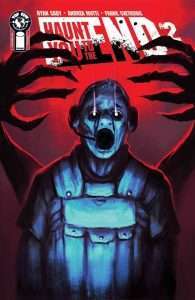 Callum Shah, an eccentric billionaire (can’t one of these people be normal?) is on the hunt for proof of life after death, amidst worldwide ecological catastrophe. And, given what we see of the end of the world in Haunt You to the End #2, a non-corporeal existence may be preferable to the cancer riddled, flooded, nightmare planet we see depicted in this issue.
Callum Shah, an eccentric billionaire (can’t one of these people be normal?) is on the hunt for proof of life after death, amidst worldwide ecological catastrophe. And, given what we see of the end of the world in Haunt You to the End #2, a non-corporeal existence may be preferable to the cancer riddled, flooded, nightmare planet we see depicted in this issue.
Most of everyone in this series is along for the ride, mainly to be fed and protected while the planet turns to hell in a handbasket. The world depicted in Haunt You to the End #2 is a flooded out, refugee ridden wreck, the sad culmination of thousands of years of neglect and abuse. Shah’s search for life after death as a way of escaping the hellscape he and others of his ilk helped create with their rapacity and self indulgence is yet another example of the lack of understanding and foresight in all their endeavours. Sure, you can put people on Mars, but what’s the point? Similarly, we might all like the idea of floating around playing harps in a cloud filled wonderland, but again, what’s the point?
Of course, when there is a believer (and his enabling padre, Domingo Sandoval) there are non-believers, in this case the cynical Suzanne ‘Gersh’ Gershwinn and her merry band of soldiers hired on by Shah to provide security while he and his team investigate two haunted locales – the Manor and the Derricks. So far these characters fill their niche within the story – to be hard bitten, or cynical, or both, essentially cannon fodder and plot advancers, as the story requires. There’s nothing wrong with that, but it is enough to drop the rating on this story a couple of points, mainly because it is the sort of thing we’ve all seen and read before.
And this is where the real strengths of Haunt You to the End #2, the artist Andrea Mutti, comes to the fore. To be sure, the writing is average at best – when you are dealing with stereotypes, the writing does have a ‘been there, done that’ feel. But the artwork, with its tentative line work, excellent use of smoke effects, and the tumbledown feel not only of the Manor, but of the very surroundings themselves, taps ably into the theme of dissolution and what might lie just beyond the veil of existence, more so than the writing itself.
Mutti’s artwork really comes to the fore when the journalist character, Matt Park, has an encounter with the ineffable in the one truly memorable scene in Haunt You to the End #2. Some artists would go to great lengths to depict what Park sees in all its grotesque glory – instead, Mutti gives the reader just enough of a hint of what Park is glimpsing, and no more. In that way, Mutti relies on the overactive imagination of the reader to fill in the gaps of what has been suggested, enough to convey the true horror of what is only hinted at on the page. It demonstrates Mutti’s skill to the fullest.
Haunt You to the End #2 is an enjoyable, if slight romp. Shah’s ultimate aim is unknown, but on the face of it, writer Matt Cady is having some fun at the expense of those tech billionaire’s tinkering with your favourite social media sites. The set up, of a world heading for the gurgler, is not unique in horror, the artwork used to depict it is top notch, and worth buying the issue alone.
Read Haunt You to the End #2The post REVIEW: Haunt You to the End #2 appeared first on Grimdark Magazine.
July 29, 2023
REVIEW: Secret Invasion- Episode Four ‘Beloved’
Secret Invasion 1×04 “Beloved” is the fourth episode out of a six episode miniseries that is supposed to be about the Skrull invasion of Earth. However, it’s mostly been about a couple of thwarted (as well as one not so-thwarted) terrorist attacks by the questionably competent Gravik. This is something that has been dragging the show as well as the killing of multiple well-liked characters. Basically, I don’t buy Gravik as a competent antagonist and given he’s up against Nick Fury, that just makes the entire thing fall apart.
Warning, this review will contain spoilers.
The premise for “Beloved” is that Nick Fury’s wife, Varra, has been given the mission of killing him by James Rhodes’ replacement. Yes, it turns out that Rhodey has been replaced by a Skrull infiltrator and that sadly undermines their conversation in “Promises.” Varra is conflicted about killing Fury even though Gravik is someone that she swore her allegiance to a long time ago. Also, she was apparently assigned to entrap him as a honey pot many years prior. This is easily the best part of the episode and probably deserved its own episode to focus on it.
Instead, most of the episode is focused on Gravik’s plot to kill the United States President and frame Russia for the attack. Which, fine, that’s a perfectly good evil plot and better than the previous couple that have happened. It’s fine and is a pretty good action scene but it also ends in yet another major character death that feels unnecessary and without sufficient build-up. This is one of the big flaws of Secret Invasion, it doesn’t know how to milk any actual drama from its deaths.
Basically, since Maria Hill was killed in episode one, fans have been confused as to whether any deaths would “stick” or not. After all, anyone killed during the show could end up being a Skrull at the end. That was one of the features of the original Secret Invasion comic. They brought back Mockingbird among several other dead characters and almost brought back Gwen Stacy (seriously). So, fans don’t know if they should be shocked or not whenever a major character is killed.
This is demonstrated by the revelation that G’iah, seemingly killed the previous episode, turns out to have survived. This is good because Emilia Clark is a fantastic actress and I kind of wonder what would have happened if this hadn’t been a TV show but had been a movie with her as Spider-Woman and Queen Veranke. Maybe have some actual superheroes be replaced and ended with General Ross becoming President due to killing the Skrull Queen. You know, something like the actual comic.
Either way, no sooner do we have it discovered that G’iah survived then we have Talos seemingly killed. I don’t know if we’re meant to take it seriously or not. If so, it seems like another waste of a good character for a mediocre storyline. We also only have two episodes left and I’m not sure the plot has gotten started let alone is ready to come to an end.
The post REVIEW: Secret Invasion- Episode Four ‘Beloved’ appeared first on Grimdark Magazine.

